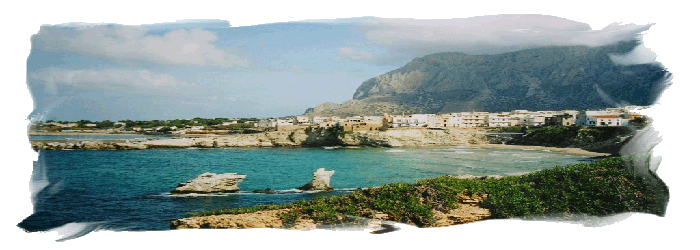Vucciria einer der ältesten M ärkte Palermos
ärkte Palermos
man muß ihn sehen,
hören, riechen, erleben
more photos >>>
il silenzio
della Vucciria >>>
Ferien
in Sizilien >>>
THE Vucciria, in the heart of
Palermo's historic old city, opens early. By 4 a.m., fishermen are hauling in
the day's catch; by 5 a.m., vendors are setting out crates of fruit and
vegetables; and by 6 a.m., the place is bustling with shoppers. It's a tradition
that's gone on, more or less the same way, for the last 700 years.
Every day
but Sunday, the Vucciria fills with fishermen, shopkeepers and merchants who
have come to peddle their goods. And it's quite a selection: pasta, grains,
sacks of beans, bags of dried herbs, shoes, socks, cigarette lighters shaped
like handguns, grappa, wine, CDs, paintings and paperweights of the Madonna,
salted capers (a local specialty), zucchini the size of a child's leg, crates of
artichokes still attached to their long stalks, tomatoes (large, small,
sun-dried, packed in oil, in a can, on the vine) and practically anything else
you can think of.
Strolling through the maze are the market regulars: men
in coppolas, the forward-leaning Sicilian caps, like the one Al Pacino wore in
“The Godfather”; and elderly women in heavy tweed skirts, stiff pocketbooks
hanging from their elbows. The smattering of curious tourists don't arrive in
Palermo, the crumbling city on the northwest end of Sicily, until the
summer.
The center of the outdoor market is the Piazza Caracciolo, the
fishermen's square. I arrived as dawn crept over the buildings. Rickety tables
were propped up by plastic milk crates, and men in tall rubber boots and stiff
red aprons laid out the morning's catch on sheets of crushed ice under bright,
unforgiving light bulbs dangling from the tarps overhead. The fishermen, stray
cats at their ankles, chopped swordfish steaks with cleavers and wrapped
handfuls of shrimp in white paper for their early customers. Every so often, the
fishermen poured water over their catches — red mullets, shrimp, squid, sea bass
and marlin — the excess spilling on to the piazza's stones.
There's an
expression in Sicily: “Quannu s'asciucanu i balati dà Vucciria,” which means
“when the streets of the Vucciria run dry,” the equivalent of when hell freezes
over. In other words, it could never happen. But it is happening. By midday on a
recent Friday, the worn white stones of the piazza were nearly bone
dry.
After 700 years, the Vucciria is fading.
“Everything has
changed,” said Ignazio D'Alessandro, a 62-year-old man with white hair and a
round face who has been selling fruit in the Vucciria for 57 years. “It hasn't
been the same since Orlando left,” he added, referring to Leoluca Orlando, the
anti-Mafia mayor of Palermo who prevented developers from razing old
neighborhoods, before leaving office in 2000. “There's new construction, new
developments all around. The Vucciria won't survive.”
This is a common
sentiment around these parts. After World War II, when much of Palermo was
bombed to rubble, Mafia-controlled construction companies seized the opportunity
to erect inexpensive new buildings rather than refurbish old ones, and the trend
has continued since. The result has been the gradual expansion of square, gray
concrete buildings squeezing in on the Vucciria.
The market reaches from
the heavily trafficked Via Roma down to the water. But what once covered dozens
of city blocks has dwindled to only a few. Mr. D'Alessandro is one of the
Vucciria's oldest tenants. He took over the fruit stand from his father, who had
taken it over from his father before that.
“I've lived here since I was
5,” Mr. D'Alessandro said from his perch behind crates of apples, oranges and
prickly artichokes. “I used to employ five people, but now it's just me. It used
to take an hour to get through one block of the Vucciria, but now you can walk
it under a minute. The crowds are leaving. The developers are moving in. I'll
have to close in the next two years.”
As I started to leave, Mr.
D'Alessandro clasped my hand, and said he had something for me — a gift from the
Vucciria. He gave me a small plastic cup filled with what looked like pink
water. “It's artichoke wine,” he said. “I make it myself — good for the
digestion.”
Another Vucciria fixture is the Shanghai Trattoria (Vicolo
Mezzani, 34; 39-091-589-702), a small home-style restaurant full of eclectic
furnishings and the smell of garlic. Perched on a balcony above Piazza
Caracciolo, the trattoria has been in the same family for 41 years. “This area
and this restaurant have always been popular among artists and poets,” said
Maria Concetta, the owner, who said that cast members from “The Godfather” ate
at her restaurant while filming. And Renato Guttuso, the Italian artist,
anti-Fascist and recipient of the Lenin Peace Prize, painted his 1974
masterpiece, “La Vucciria,” of the market in full swing, from the trattoria's
veranda.
“It's different today,” Ms. Concetta said. “But there are still
days you can find the old Vucciria.”
>>>next
Monday, February 11, 2008
Sicily Sicilia Reisetipps Rundreisen von UllaeGino Sizilien Ferienwohnung Terrasini am Meer
Rubrik: Ferienwohnung Terrasini, Geschichte, Lifestyle, Palermo, Reisetipps, Rundreise, Sicilia, Sicily, Sizilen, sizilianische Kueche, Sizilien Ferienwohnung, Urlaubsplanung
